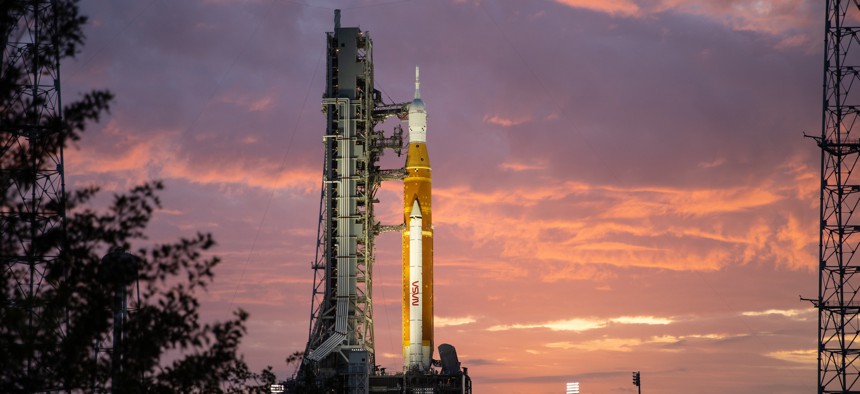Leidos relishes background role for Artemis rocket launch

The Artemis I rockets on the launch pad ready for its Aug. 29 lift off. NASA
The company's ideal and best outcome: no one notices them on launch day.
NOTE: NASA scrubbed the launch of Artemis one because of an engine issue. No word yet on when the launch will be rescheduled.
NASA’s Artemis I rocket lifts off Monday morning from the Kennedy Space Center in Florida on a test flight to the moon and back.
Over the course of 43 days, various systems will be put to the test as NASA prepares for human flights to the moon and then Mars.
Real science will happen with the help of cubesats – small satellites that will conduct a variety of experiments including searching for water, mapping hydrogen and performing infra-red imaging of the lunar surface.
NASA will make headlines at liftoff and throughout the mission as the rocket sets performance records and reaches new milestones.
Much like how the James Webb Space Telescope is sending unprecedented images back from its orbit around the sun, Artemis I gives NASA another opportunity to flex its science muscles and excite the population with the importance and potential of its mission.
The space agency wants a lot of attention on the launch and mission. But Leidos' team managing the IT infrastructure for NASA during the Artemis mission has a different and simpler measure of success – nothingness.
“On mission day we have an opportunity to shine but for us to shine means nothing happens,” said Nate Apodaca, vice president and division manager of Leidos’ NASA portfolio.
The company is managing the IT infrastructure supporting both missions through its large contracts with NASA, such as the $2.5 billion Advanced Enterprise Global Information Technology Solutions award and the $2.9 billion End-User Services & Technologies program.
At a high level, Leidos is managing all of the end-user devices used during the launch. That support extends to the backend network infrastructure, camera systems surrounding the launch vehicle, Wi-Fi connectivity and NASA TV.
“It’s all the infrastructure in use at the center as well as all of the different centers involved,” Apodaca said.
Over the days leading up to the launch and during liftoff itself, Leidos will have nearly 1,000 people working to keep the NASA computer networks and infrastructure up and running.
“It’ll be all hands-on deck from Sunday through Tuesday,” he said. “We’ll have people at all the launch facilities at Kennedy. We are also plussed-up at Johnson Space Center (in Houston), where there’s a lot of telemetry data and the mission center will manage Artemis once it gets to a certain height.”
Leidos also has people working at the Marshall Space Flight Center in Huntsville, Ala.
“There is so much redundancy – primary, secondary and tertiary support mechanisms for the mission systems and all the technical services as well,” Apodaca said.
Artemis' launch is different than the others Leidos has supported in the past. Apodaca called it a “heartbeat of America launch,” because Artemis will ultimately carry people to the moon and then to Mars.
“This is probably the most influential launch NASA has had since the very first space shuttle,” he said. “So it garners a bit of nervousness, but also focus. It’s a hugely important mission for NASA.”
Liftoff is scheduled for 8:33 a.m. Eastern time on Monday (many of you may be reading this after Artemis I is in the air).
Sitting on top of the rocket is the Orion spacecraft, which will be used to eventually carry people. Dummies are on board for Artemis I so NASA can evaluate potential human impacts during the flight.
The craft will travel 1.3 million miles and will orbit the moon for about one month before its return to Earth and splashdown scheduled for Oct. 10.
Artemis II will take people on a similar journey to the first mission, and then Artemis III will attempt to land humans on the moon again. Those flights are expected in 2024 and 2025.
Leidos will manage the IT infrastructure while all of that happens and and critical technologies NASA is using in areas like advanced analytics, artificial intelligence, machine learning, robotic process automation and tools based in cloud environment.
“It allows for easier, faster, quicky tracking of data,” Apodaca said. “It really opens the aperture for the art of the possible.”
One area is the modeling and testing that Leidos has been doing ahead of the launch. The company has been trying out different approaches such as on-premise computing versus the commercial cloud as well as tuning network speeds.
“We can model and test all of that now and then once we implement it, it’s simple and really bolsters the mission,” Apodaca said. “IT is a huge mission enabler, but we want to be as invisible and non-intrusive as possible.”
NEXT STORY: Sev1Tech promotes new tech chief from within
